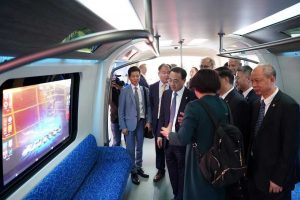The railway sector has grown considerably in China since the beginning of the 2000’s. Now dubbed the country of high-speed trains, China saw its rail and urban networks quickly densified. Chinese rolling stock manufacturer CRRC (中国中车) intends to emancipate itself from Western competitors and use new materials such as carbon fibre to make a difference.
At the last Innotrans trade fair in Berlin, Germany, CRRC Qingdao Sifang (中车青岛四方), a subsidiary of Chinese giant rolling stock manufacturer CRRC, caused a stir while presenting its carbon fibre metro vehicle, baptized CETROVO.
According to Ding Sansan, deputy chief engineer of CRRC Sifang, the “new-generation metro vehicle” incorporates advanced carbon fibre technology: the car body, the bogie frame, the driver’s cab, the equipment cabinet and the equipment body are all made of carbon fibre composite materials. It is a metro vehicle with large-scale application of carbon fibre composite materials. In particular, key technical difficulties in structural design and moulding of large, complex carbon fibre parts were solved.
In terms of weight, Ding Sansan stresses that this carbon fibre metro vehicle is much lighter than those using traditional metal materials such as steel and aluminium alloy. The car body, driver’s cab and equipment cabinet are 30% lighter, the bogie frame is 40% lighter and the complete vehicle is 13% lighter.
Alstom’s IHC solutions
« A composite material, whether based on carbon or glass fibre, generates a significant extra cost because it is expensive and complex to implement. In aeronautics, for example, Airbus does not use more than 50% composite materials due to their very high cost », argues Bernard Tritz, director of Alstom’s Car Bodyshells centre of excellence. The French multinational has been present for several decades in China, where it operates six joint-ventures and has been participating in a large number of railway projects, including a complete range of rolling stock (metro trains, high-speed trains, locomotives and tramways), customised services, infrastructure, and signalling solutions.
Bernard Tritz explains that Alstom has been interested in integrating composite materials for almost 20 years, conducting studies and programmes for the construction of structural elements or complete vehicles made of composite materials. In 2011, a subway car was developed and built by a consortium with other companies (including EADS and Stratiforme Industrie) and testing laboratories. The car was subjected to static tests at a fixed station and local fatigue tests.
A mix of glass and carbon fibres was used to build the car’s structure. In addition to this experience on a subway case, Alstom carried out tests on high-speed train crate ends installed on test cars, as well as a body bolster and a bogie chassis.
« With this experience in mind, our strategy concerning the structural part of trains does not favour the all-composite model because the exchange rate (cost of suppressed weight) is too high and calls for an optimized mix of different materials », says Bernard Tritz.
This feedback led Alstom to focus on multi-material concepts with integrated functions that aim to reduce weight at the same cost as the current designs. These concepts are implemented through IHC (Integrated Hybrid Concept) solutions, which focus on using the right materials at the right places. The combined use of these materials – whether wood, foams, carbon fibre or metal – makes it possible to meet not only structural requirements but also other needs such as insulation for example. This is the functional integration concept.
« The use of IHC solutions offers value to customers and benefits for passengers. The weight saved can be valuable for the customer as the train will consume less energy, its wheels will wear out less quickly, and the impact on the operator’s infrastructure will be lessened », concludes Bernard Tritz.
CRRC: saving more than 15% energy
CRRC estimated that the CETROVO can altogether save more than 15% energy.
« Although the manufacturing cost of carbon fibre composite materials is higher than traditional metal materials, the former are much lighter and have obvious energy-saving advantages. They also have excellent performance in terms of fatigue resistance, tolerance to different weather conditions and corrosion resistance, which ensures the metro vehicle will avoid fatigue and corrosion failures in its 30-year service life. Thus, maintenance work is reduced and the entire life cycle cost is decreased », Ding Sansan stresses, adding that a lighter vehicle also reduces damage to the metro line.
In addition to carbon fibre lightweight technology, the CETROVO is equipped with a new energy-efficient traction system to achieve better energy efficiency. By upgrading the asynchronous motors used by traditional metro vehicles to the direct drive technology of permanent-magnet synchronous motors and adopting a silicon carbide converter device, the vehicle’s traction efficiency was greatly improved.
However, according to Bernard Tritz, other parameters should be considered. « Alstom is also committed to improving the acoustics onboard trains for passengers’ comfort. In addition to their high cost, composite materials do not have very good acoustic insulation properties. To compensate for this lower performance, a manufacturer using 100% composite materials has to add insulating elements, thus increasing cost and weight. »
Costly comfort and intelligent services

CRRC did obviously not skimp on the means for its new-generation metro vehicle, which incorporates advanced vibration and noise reduction technology.
« When a metro vehicle is running, it will vibrate due to track irregularity, and the vibration should be reduced through the suspension system on the bogie. The CETROVO is designed with a full-active suspension system for the first time: any vibration of the vehicle during operation is immediately detected and the damping action of the suspension system is subject to dynamic adjustment. In this sense, the suspension system can always suppress vibration very efficiently, resulting in high riding quality”, says Ding Sansan, who specifies that « it is also quieter inside the vehicle. As the noise reduction design is optimized, the noise level in the passenger compartment is only 68 dB when the vehicle is running. »
CRRC’s carbon fibre metro vehicle is also equipped with intelligent services, which can be found in each detail of the vehicle. The passenger compartment is just like a touchscreen computer. To be specific, the car window acts as a super touchscreen to provide various graphics, texts and videos. Passengers can watch news, browse the Web, buy tickets, watch videos and live TV shows on the window. All these services are easily accessed by passengers by simply touching the window with their finger. The mirrors in the compartment also support touch technology and are provided with Internet access.
The air conditioners in the compartment can automatically choose the appropriate temperature and humidity according to the actual weather and dressing index, making passengers feel more comfortable. The lighting system keeps track of the light environment and automatically adjusts the brightness and colour temperature. In addition, multimedia curved screens, self-cleaning seats and hearing aid systems for hearing-impaired passengers are also provided. All these intelligent services will bring a new travelling experience to passengers.
Judging by the reactions of the Western press, the Chinese giant succeeded in impressing everyone in Berlin and give a clear idea of its international ambitions. According to State-owned CGTN (China Global Television Network), with products including high-speed trains, metro and intercity vehicles, CRRC Qingdao Sifang is now eyeing overseas markets such as Southeast Asia, the U.S. and South America. To be completed by the beginning of 2019, the merger between Alstom and Germany’s Siemens aims to create a group with a size to resist it.
This article has been commissioned and published by JEC Group





